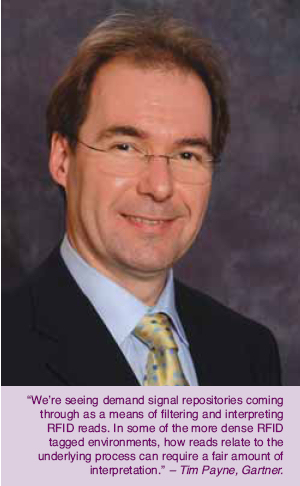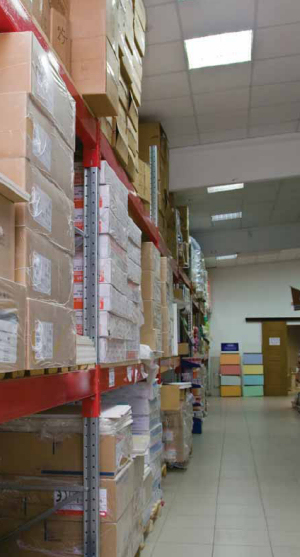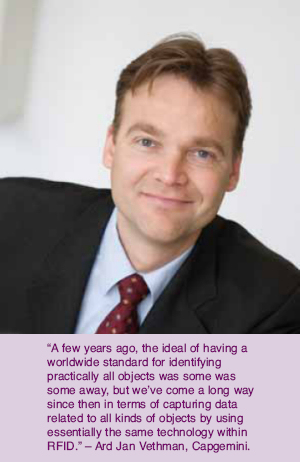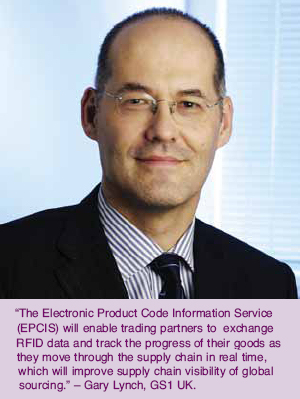 RFID where are we at, where are we headed, and what are the benefits and opportunities to be had for resellers? IT Reseller spoke to some of the leading names from the analyst, trade association and standards community.
RFID where are we at, where are we headed, and what are the benefits and opportunities to be had for resellers? IT Reseller spoke to some of the leading names from the analyst, trade association and standards community.
Many industry commentators refer to RFID as a transformational technology in automated data capture, something that is going to have a major impact on all our lives, both at a consumer and business level. And it is thought by some that as vendors strive to develop more out of the box hardware, volumes will increase and prices will eventually fall. Also, it is believed that consulting and integration opportunities will be plentiful. However, some say there has been a slow take up of RFID over the past few years, but because it is such a major paradigm shift the market cannot expect mass adoption overnight. Ongoing work on standards is undoubtedly one of the key issues. However Ard Jan Vethman, RFID leader, global sector manufacturing retail & distribution, Capgemini, points out that over the past three or four years, greater consolidation of standards for capturing data from RFID tags on objects has made positive and rapid progress over the past few years. Weve really made a jump since this process began around 2002, he said. Back then, the ideal of having a worldwide standard for identifying practically all objects was some was some way away, but weve come a long way since then in terms of capturing data related to all kinds of objects by using essentially the same technology within RFID. This covers everything from individual garments, boxes and books to higher-level packaging such as pallets and roll cages. And the means of capturing all this data is now really starting to come under one umbrella. We have standards for passive tags and we are beginning to also consolidate on active tags. In the near future we should be able to have a very open standards-based platform to capture events and identify objects big and small throughout the supply chain; and also extending into other industries as well.
Absolutely essential
 Tim Payne, research director, SCM EMEA, Gartner, picks up the theme of standards, believing that it is absolutely essential for standards work to continue if the market is going to see more widespread adoption of RFID. He also highlights the fact that the market is currently seeing the combination of different types of technologies, such as GPS with RFID. This is being used on some asset tracking solutions and solutions that are feeding into things such as yard management, he said. Interpretation of data is another hot topic in the world of data capture, as Payne explained: Were seeing demand signal repositories coming through as a means of filtering and interpreting RFID reads. In some of the more dense RFID tagged environments, how reads relate to the underlying process can require a fair amount of interpretation. So the development is to be able to feed the data into a more RFID-centric business application that can cope with that. The real value will come from being able to re-architect business applications to be able to really interrogate those reads and to interpret them. Then that starts to open up more significant opportunities in terms of where RFID can be used and in the types of business processes that it can support. Were just seeing the beginnings of this level of interpretation.
Tim Payne, research director, SCM EMEA, Gartner, picks up the theme of standards, believing that it is absolutely essential for standards work to continue if the market is going to see more widespread adoption of RFID. He also highlights the fact that the market is currently seeing the combination of different types of technologies, such as GPS with RFID. This is being used on some asset tracking solutions and solutions that are feeding into things such as yard management, he said. Interpretation of data is another hot topic in the world of data capture, as Payne explained: Were seeing demand signal repositories coming through as a means of filtering and interpreting RFID reads. In some of the more dense RFID tagged environments, how reads relate to the underlying process can require a fair amount of interpretation. So the development is to be able to feed the data into a more RFID-centric business application that can cope with that. The real value will come from being able to re-architect business applications to be able to really interrogate those reads and to interpret them. Then that starts to open up more significant opportunities in terms of where RFID can be used and in the types of business processes that it can support. Were just seeing the beginnings of this level of interpretation.
Mark Blowers, enterprise architectures practice director, Butler Group, believes developments in RFID are revolutionising the way the supply chain is managed and controlled, in the same way that the development of natural voice interfaces has also been a major step forward enabling the move away from structured questions and menu-type interfaces. Ian Byfield, communications manager, European Centre of Excellence for AIDC, comments that over the past few years AIDC technologies in general have at last understood the requirement to integrate more closely with other technologies; so that wide-area wireless communications are now an element of a significant proportion of AIDC installations. With specific regard to RFID, Byfield points out that the allying of RFID tags with sensors and location systems has also been a significant move.
Gary Lynch, chief executive for GS1 UK, highlights the fact that EPCglobal has facilitated the creation of Gen 2 a global RFID standard that has reduced costs and improved performance. This standard defines the physical and logical requirements for a RFID system, he said. On the subject of AIDC in general, Lynch points out that another technological development has been the introduction of a new bar code the GS1 DataBar. GS1 DataBar offers the ability to barcode difficult-to-mark products, including items that have a size or shape not suited to traditional bar codes, he explained. It will also offer the ability to include extra information such as serial numbers and expiry dates, alongside the GTIN (product identifier). The global adoption date for the new barcode will be 1 January, 2010.
Channel focus
From a channel perspective, Blowers emphasises that it is important for resellers to gain knowledge and expertise of new and upcoming technologies such as RFID, so that they are able to provide the necessary support and add value required by the end customer; and therefore further cementing their business relationship/partnership. Also, adds Blowers, customers much prefer a solution rather than just point products. From a user perspective there is a need to look beyond the technology/product and focus on business process improvement, he said.
Prototyping particularly from an RFID perspective is a really big want from the users side, Payne emphasised. Users want to understand the level of ability of the vendors or resellers theyre dealing with and to feel confident that they are able to help develop a solution that meets their needs; they want the people theyre dealing with to be able to prove their abilities. Part of this process involves the provider helping in the development of a business case. Some end users have an idea as to where and how they could use technology such as RFID. What they sometimes struggle with is turning their plans into a tangible and believable ROI. So they need the vendors or resellers experience and help to make it work.
Byfield points out that, in general, AIDC technology principles are about 20 years old. It is too easy to believe that both the reseller and user communities are mature in their knowledge of the subject, he said. In fact, there is a large and increasing need for real knowledge and understanding among both communities. Byfield maintains that training must be taken seriously by resellers, and that the user community needs to be given a means of discovering the broader possibilities of a widening AIDC church so that it can be better equipped to make effective and worthwhile decisions about AIDC installation projects, including those related to RFID. Thus the stature of the industry is enhanced, said Byfield.
 Developing markets
Developing markets
Lynch points out that in Europe, Metro Groups use of the full EPC (Electronic Product Code) standard set in a mandated deployment of RFID has opened up the market for solution vendors, distributors and resellers. Walmarts decision to mandate its deployment of RFID has also opened up a large market in the US, he said. The adoption of RFID in the UK has also been growing with businesses such as Marks & Spencer and The Co-op realising the benefits of their deployments.
Vethman highlights the fact that there have been vertical sectors where RFID adoption rates havent been as great as some people expected them to be four or five years ago. The box-level trials at Walmart in the US, for example, were expected to grow very rapidly to a major size, and this implementation hasnt grown as quickly as expected by some, he said. However, he added that the market has seen other areas where take-up of RFID has been impressive in terms of how quick adoption has taken place. One example of item-level tagging can be seen in many of the leading academic book stores in the Netherlands, where each book in the stores is RFID tagged, he said. Some of the stores hold around 70,000 titles, so you can see the benefits in terms of speed and efficiency of relying on RFID. Indeed, RFID is being rolled out rapidly now to cover all the 40 major academic bookstores.
According to Vethman, fashion retail is another example where adoption has been more rapid than some sectors, and RFID traction can be witnessed in the fact that many companies are moving from trial and pilot schemes to implementation in returnable assets; the totes, roll cages, etc. Here, companies are achieving some impressive benefits in terms of supply chain visibility, said Vethman. He also made the point that many RFID projects are not particularly visible to the consumer; instead tending to involve the logistics between manufacturers and retailers and often not ending up on the shop floor.
Byfield believes that certain types of RFID will certainly continue to grow in application and take-up. Among the many successful RFID applications he cites are: electronic seals for trailers; baby protection devices; tracking tyres at the races; directing gantry cranes; solar-powered asset tracking (tags on sign posts); and worldwide diamond inventory.
Lynch has observed increased levels of RFID adoption globally, with many mandating their deployment. In Europe, the Metro Group has deployed RFID on a full scale, equipping roughly 200 locations with RFID infrastructure, and it expects 650 of its top suppliers to begin shipping RFID-tagged product by early 2008, he said. Metro has deployed an RFID system at its Galeria Kaufhof high-end retail store in Essen, Germany, involving item-level tagging based on Gen 2 and related EPCglobal RFID standards. Blowers too reports well on healthy adoption rates, based on feedback he has received from the vendor community. He added that although adoption rates may be havent been as rapid as many had predicted, the RFID trend is growing. Blowers added that, with any relatively new technology there can be a lag between the expectations and the actuality. Wireless technologies seem particularly prone to this, he said. The development of the standards can slow down adoption, as can in RFIDs case the integration with back-end systems; the complexity of which is often underestimated.
According to Lynch, an important part of the RFID adoption process is to plan, experiment with and test an organisations processes in order to develop a sound business case and implementation plan. He points out that facilities such as the EPCglobal RFID Test Centre (UK) enable companies to test how RFID may react in a replica real-life environment in a controlled, safe way. Lynch also believes issues such as the compatibility of RFID UHF bandwidths worldwide were barriers to RFID adoption. However, he highlights the fact that last year Chinas UHF bandwidth for the use of RFID tags and interrogators were approved to be compatible with UHF RFID frequencies used in the US and Europe.
From a geographical perspective, the activity levels Payne observes in places such as China are still very early in their development stages. There isnt a great deal of activity over there, the focus is still on putting some fairly basic applications in place and labour is so cheap that you simply dont have the same business case, he said. However, if one looks at productivity improvements with RFID in a Europe company, thats a different proposition, believes Payne. Nevertheless, he anticipates that Western customers will start looking at using RFID at Chinese ports from a tracking perspective. This should at least start to push that technology into the export end of the supply chain in the region; so adoption will be influenced from outside as opposed to inside, he said. India, on the other hand, is a rather different case, according to Payne. This area is really quite gung ho generally around new technologies, and there is a number of Indian retailers who are really trying to make this type of technology work probably harder than some companies we have in Europe, said Payne. They see huge potential because their infrastructure often isnt as good as in the West, and so they see technology such as RFID as a means of circumventing this problem and gaining better control and visibility. And India has a huge pool of resource and talent that can leverage this.
 Barriers
Barriers
And what of further elements that can help hinder adoption? Blowers again picks up the theme of standards, believing that the lack of development of standards for data in the RFID world is a reason why the technology cannot deliver the real-time data exchange between trading partners. In addition, Blowers believes the volumes of data potentially generated from RFID tags remains an issue, as does the integration of the technology with other wireless technologies and existing systems. Byfields view is that price, ignorance (among some providers and users), scaremongering and confusion as to what RFID is (i.e. a wide range of differing technologies with different qualities and uses) can proved to be barriers to adoption. For Lynch, the main barriers to RFID adoption currently are organisations not taking the time to investigate which of their processes or which areas of their data could benefit from RFID.
As for the barcode, will it continue to dominate the data capture space for the foreseeable future, despite the growing presence of RFID in some quarters? Blowers has no doubt that the barcode will continue to be widely used, mainly due to the investment in equipment, its simplicity, mature standards, and low cost. Byfields view is that barcodes will continue to find application in vast areas of industry and commerce where simple and effective systems of unique identification are required. Well-established transport label systems will take some replacing, especially when they are required to be used across national borders, he said. Add 2D coding into the equation as data carrying devices and there may even be a relatively higher proportion of growth in this area than others.
 Horses for courses
Horses for courses
Lynchs view is that the case with RFID and the barcode is still very much one of horses for courses. While the two technologies have similarities, they have strengths in different areas and therefore different uses for identifying goods from the manufacturer through to the point of sale. Working in tandem, RFID and barcodes can track all types of goods throughout the supply chain using both methods of identification to help with traceability, product recalls and anti-counterfeiting. RFID is appropriate for use in the wider supply chain. Since it does not require line of sight for scanning, it can easily track and trace cases, pallets, roll cages and high value goods throughout the supply chain to ensure that they arrive in the right place at the right time. Items such as loose produce dont need to be uniquely identified, so RFID tags or an Electronic Product Code (EPC) makes no commercial sense there would be no business benefit to embedding an RFID tag on a can of baked beans, for example. In this case, it would be best to identify the can of baked beans with a barcode.
For Vethman, RFID adoption may be growing at an impressive rate, but barcoding will still be applicable for a long time to come. It doesnt make economic sense to try to put an RFID tag into everything that can currently carry a barcode, he said. As an example, its great that when you check in online for a flight and your printer produces a barcode on paper. It would be ridiculous to try to make that an RFID tag. GS1 has introduced some innovations on barcoding to capture more data and so I believe it is more than capable of living side by side RFID for the foreseeable future.
Back office integration and middleware
In terms of the basic technology needed to connect between parties or between systems, Vethman believes this has certainly come a long way over the past few years; and Web Services is one example of this. But I think the real issue is not so much about connection between systems per se but how you can transmit the data in such a way that it makes sense at the receiving end, he said. This has to do with data standards, and capturing data in a standard format in order to make the data immediately comprehensible, as well as the context in which it was created. It is one thing to understand that it is a reader or a tag, but you also need to understand where that reader was placed at that time, what was the business process that was being performed, was it loading or was it receiving and so on. So there potentially remain some issues regarding effective, seamless back-end integration. But there are great strides currently being made to have all of this in the right GS1 standard in the near future.
As regards middleware between the mobile data capture solutions and back office systems, Payne believes this has developed but still has some way to go in terms of moving on to the next stage. And the development of middleware will help to really crack the value of RFID going forward as well, he said.
Looking forward
Blowers concludes that the future for RFID adoption looks bright: RFID will become increasingly more pervasive; being used, for example, in retail outlets on individual products and in ticketing applications. He also foresees the increased integration of RFID with other wireless technologies and location tracking solutions. Lynch highlights the fact that the global adoption date of 1 January, 2010 for the GS1 DataBar will mark when the barcode will start appearing at retail check outs. In terms of RFID, Lynch points out that the Electronic Product Code Information Service (EPCIS) will enable trading partners to exchange RFID data and track the progress of their goods as they move through the supply chain in real time, which will improve supply chain visibility of global sourcing.

Add a Comment
No messages on this article yet